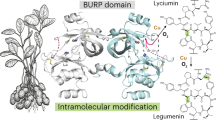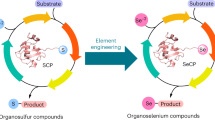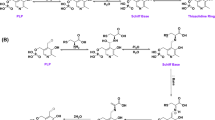Abstract
Natural products containing phosphorus–carbon bonds have found widespread use in medicine and agriculture1. One such compound, phosphinothricin tripeptide, contains the unusual amino acid phosphinothricin attached to two alanine residues. Synthetic phosphinothricin (glufosinate) is a component of two top-selling herbicides (Basta and Liberty), and is widely used with resistant transgenic crops including corn, cotton and canola. Recent genetic and biochemical studies showed that during phosphinothricin tripeptide biosynthesis 2-hydroxyethylphosphonate (HEP) is converted to hydroxymethylphosphonate (HMP)2. Here we report the in vitro reconstitution of this unprecedented C(sp3)–C(sp3) bond cleavage reaction and X-ray crystal structures of the enzyme. The protein is a mononuclear non-haem iron(ii)-dependent dioxygenase that converts HEP to HMP and formate. In contrast to most other members of this family, the oxidative consumption of HEP does not require additional cofactors or the input of exogenous electrons. The current study expands the scope of reactions catalysed by the 2-His–1-carboxylate mononuclear non-haem iron family of enzymes.
This is a preview of subscription content, access via your institution
Access options
Subscribe to this journal
Receive 51 print issues and online access
$199.00 per year
only $3.90 per issue
Buy this article
- Purchase on Springer Link
- Instant access to full article PDF
Prices may be subject to local taxes which are calculated during checkout




Similar content being viewed by others
References
Seto, H. & Kuzuyama, T. Bioactive natural products with carbon–phosphorus bonds and their biosynthesis. Nat. Prod. Rep. 16, 589–596 (1999)
Blodgett, J. A. et al. Unusual transformations in the biosynthesis of the antibiotic phosphinothricin tripeptide. Nature Chem. Biol. 3, 480–485 (2007)
Costas, M., Mehn, M. P., Jensen, M. P. & Que, L. Dioxygen activation at mononuclear nonheme iron active sites: enzymes, models, and intermediates. Chem. Rev. 104, 939–986 (2004)
Kovaleva, E. G. & Lipscomb, J. D. Versatility of biological non-heme Fe(II) centers in oxygen activation reactions. Nature Chem. Biol. 4, 186–193 (2008)
Shyadehi, A. Z. et al. The mechanism of the acyl-carbon bond cleavage reaction catalyzed by recombinant sterol 14 alpha-demethylase of Candida albicans . J. Biol. Chem. 271, 12445–12450 (1996)
Dunwell, J. M., Purvis, A. & Khuri, S. Cupins: the most functionally diverse protein superfamily? Phytochemistry 65, 7–17 (2004)
Higgins, L. J., Yan, F., Liu, P., Liu, H. W. & Drennan, C. L. Structural insight into antibiotic fosfomycin biosynthesis by a mononuclear iron enzyme. Nature 437, 838–844 (2005)
Grogan, G. Emergent mechanistic diversity of enzyme-catalysed beta-diketone cleavage. Biochem. J. 388, 721–730 (2005)
Xing, G. et al. Evidence for C–H cleavage by an iron-superoxide complex in the glycol cleavage reaction catalyzed by myo-inositol oxygenase. Proc. Natl Acad. Sci. USA 103, 6130–6135 (2006)
Lieberman, S. & Lin, Y. Y. Reflections on sterol sidechain cleavage process catalyzed by cytochrome P450(scc). J. Steroid Biochem. Mol. Biol. 78, 1–14 (2001)
Burzlaff, N. I. et al. The reaction cycle of isopenicillin N synthase observed by X-ray diffraction. Nature 401, 721–724 (1999)
Brown, C. D., Neidig, M. L., Neibergall, M. B., Lipscomb, J. D. & Solomon, E. I. VTVH-MCD and DFT studies of thiolate bonding to [FeNO]7/[FeO2]8 complexes of isopenicillin N synthase: substrate determination of oxidase versus oxygenase activity in nonheme Fe enzymes. J. Am. Chem. Soc. 129, 7427–7438 (2007)
Xing, G. et al. Oxygen activation by a mixed-valent, diiron(II/III) cluster in the glycol cleavage reaction catalyzed by myo-inositol oxygenase. Biochemistry 45, 5402–5412 (2006)
Kikuchi, Y., Suzuki, Y. & Tamiya, N. The source of oxygen in the reaction catalysed by collagen lysyl hydroxylase. Biochem. J. 213, 507–512 (1983)
Baldwin, J. E., Adlington, R. M., Crouch, N. P. & Pereira, I. A. C. Incorporation of 18O-labelled water into oxygenated products produced by the enzyme deacteoxy/deacetylcephalosporin C synthase. Tetrahedron 49, 7499–7518 (1993)
Sabourin, P. J. & Bieber, L. L. The mechanism of alpha-ketoisocaproate oxygenase. Formation of beta-hydroxyisovalerate from alpha-ketoisocaproate. J. Biol. Chem. 257, 7468–7471 (1982)
Lindblad, B., Lindstedt, G. & Lindstedt, S. The mechanism of enzymic formation of homogentisate from p-hydroxyphenylpyruvate. J. Am. Chem. Soc. 92, 7446–7449 (1970)
Wackett, L. P., Kwart, L. D. & Gibson, D. T. Benzylic monooxygenation catalyzed by toluene dioxygenase from Pseudomonas putida . Biochemistry 27, 1360–1367 (1988)
Pestovsky, O. & Bakac, A. Aqueous ferryl(IV) ion: kinetics of oxygen atom transfer to substrates and oxo exchange with solvent water. Inorg. Chem. 45, 814–820 (2006)
Woodyer, R. D., Li, G., Zhao, H. & van der Donk, W. A. New insight into the biosynthesis of fosfomycin: discovery of the missing link illuminates the mechanism of methyl transfer. Chem. Commun. 359–361 (2007)
Liu, P. et al. Protein purification and function assignment of the epoxidase catalyzing the formation of fosfomycin. J. Am. Chem. Soc. 123, 4619–4620 (2001)
Beinert, H. Micro methods for the quantitative determination of iron and copper in biological material. Methods Enzymol. 54, 435–445 (1978)
Shyadehi, A. Z. et al. The mechanism of the acyl–carbon bond cleavage reaction catalyzed by recombinant sterol 14 alpha-demethylase of Candida albicans . J. Biol. Chem. 271, 12445–12450 (1996)
Acknowledgements
We thank B. Griffin, J. M. Bollinger, S. E. Denmark and T. Begley for discussions. This work was supported by grants from the National Institutes of Health (PO1 GM077596 to W.W.M., W.A.v.d.D. and S.K.N., and NIH RO1 GM59334 to W.W.M.) and by the University of Illinois.
Authors Contributions R.M.C. performed all biochemical assays shown, which were designed and analysed by R.M.C. and W.A.v.d.D. All structural studies were performed and interpreted by H.Z. and S.K.N. W.W.M. designed and J.A.V.B. performed initial biochemical reactions and identified the products. J.T.W. and G.L. synthesized all substrates. R.M.C., S.K.N. and W.A.v.d.D. wrote the manuscript.
Author information
Authors and Affiliations
Corresponding authors
Supplementary information
Supplementary Information
This file contains Supplementary Methods and Data, Supplementary Figures 1-8 with Legends, Supplementary Tables 1-2 and Supplementary References. (PDF 1078 kb)
Rights and permissions
About this article
Cite this article
Cicchillo, R., Zhang, H., Blodgett, J. et al. An unusual carbon–carbon bond cleavage reaction during phosphinothricin biosynthesis. Nature 459, 871–874 (2009). https://doi.org/10.1038/nature07972
Received:
Accepted:
Issue Date:
DOI: https://doi.org/10.1038/nature07972
This article is cited by
-
Harnessing phosphonate antibiotics argolaphos biosynthesis enables a synthetic biology-based green synthesis of glyphosate
Nature Communications (2022)
-
Global and seasonal variation of marine phosphonate metabolism
The ISME Journal (2022)
-
Discovery of a pathway for terminal-alkyne amino acid biosynthesis
Nature (2019)
-
Dioxygen activation by nonheme iron enzymes with the 2-His-1-carboxylate facial triad that generate high-valent oxoiron oxidants
JBIC Journal of Biological Inorganic Chemistry (2017)
-
Go it alone: four-electron oxidations by mononuclear non-heme iron enzymes
JBIC Journal of Biological Inorganic Chemistry (2017)
Comments
By submitting a comment you agree to abide by our Terms and Community Guidelines. If you find something abusive or that does not comply with our terms or guidelines please flag it as inappropriate.



